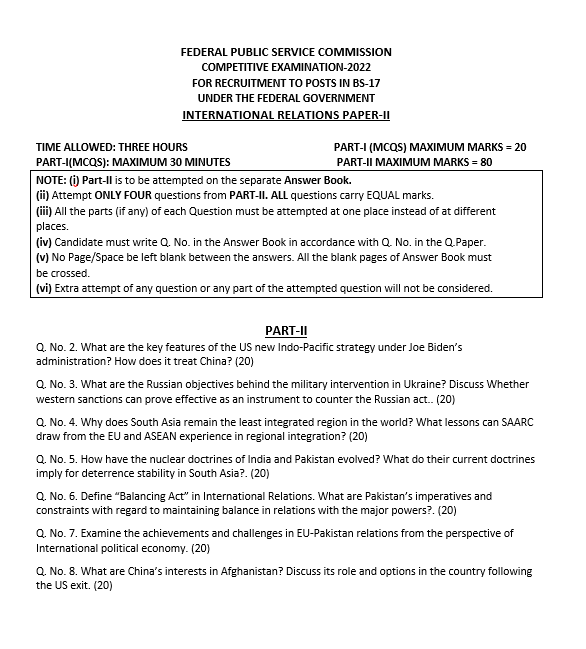CSS International Relations 2022 paper(b)
Q. No. 2. What are the key features of the US new Indo-Pacific strategy under Joe Biden’s administration? How does it treat China? (20)
Q. No. 3. What are the Russian objectives behind the military intervention in Ukraine? Discuss whether Western sanctions can prove effective as an instrument to counter the Russian act.. (20)
Q. No. 4. Why does South Asia remain the least integrated region in the world? What lessons can SAARC draw from the EU and ASEAN experience in regional integration? (20)
Q. No. 5. How have the nuclear doctrines of India and Pakistan evolved? What do their current doctrines imply for deterrence stability in South Asia? (20)
Q. No. 6. Define “Balancing Act” in International Relations. What are Pakistan’s imperatives and constraints with regard to maintaining balance in relations with the major powers?. (20)
Q. No. 7. Examine the achievements and challenges in EU-Pakistan relations from the perspective of International political economy. (20)
Q. No. 8. What are China’s interests in Afghanistan? Discuss its role and options in the country following the US exit. (20)
Summary of Questions:
Q. No. 2. What are the key features of the US new Indo-Pacific strategy under Joe Biden’s administration? How does it treat China?
The Biden administration’s Indo-Pacific strategy focuses on strengthening alliances, promoting free trade, maintaining open sea routes, and enhancing military presence in the region. It treats China as a competitor, aiming to counter its growing influence through partnerships like the Quad, economic initiatives, and military deterrence, while also seeking areas for dialogue and cooperation.
Q. No. 3. What are the Russian objectives behind the military intervention in Ukraine? Discuss whether Western sanctions can prove effective as an instrument to counter the Russian act.
Russia’s objectives include preventing Ukraine from joining NATO, asserting dominance over former Soviet territories, and maintaining a strategic buffer zone. Western sanctions aim to weaken Russia’s economy and isolate it diplomatically. While sanctions have impacted Russia’s financial system, their effectiveness in altering its political actions remains limited due to Russia’s resilience and support from allied nations.
Q. No. 4. Why does South Asia remain the least integrated region in the world? What lessons can SAARC draw from the EU and ASEAN experience in regional integration?
South Asia’s lack of integration stems from political rivalries, especially between India and Pakistan, economic disparities, and weak regional frameworks. SAARC can learn from the EU and ASEAN by fostering trust, creating robust economic ties, and resolving disputes through consistent dialogue and institutional mechanisms for conflict resolution.
Q. No. 5. How have the nuclear doctrines of India and Pakistan evolved? What do their current doctrines imply for deterrence stability in South Asia?
India’s doctrine has shifted from no-first-use to flexible deterrence, while Pakistan focuses on full-spectrum deterrence, including tactical nuclear weapons. These doctrines increase the risk of miscalculation and escalation, challenging deterrence stability in South Asia, especially during crises.
Q. No. 6. Define “Balancing Act” in International Relations. What are Pakistan’s imperatives and constraints with regard to maintaining balance in relations with the major powers?
A “Balancing Act” refers to managing relations with competing powers without alienating either. Pakistan’s imperatives include maintaining ties with China for economic benefits and the US for military aid. Constraints involve limited resources, geopolitical pressures, and balancing regional dynamics like India’s influence and Afghanistan’s instability.
Q. No. 7. Examine the achievements and challenges in EU-Pakistan relations from the perspective of International Political Economy.
Achievements include trade cooperation under the GSP+ status and EU support for development projects. Challenges include Pakistan’s human rights record, governance issues, and limited diversification of exports. Strengthening these ties requires addressing EU concerns and fostering economic reforms in Pakistan.
Q. No. 8. What are China’s interests in Afghanistan? Discuss its role and options in the country following the US exit.
China’s interests in Afghanistan include securing its Belt and Road Initiative projects, accessing natural resources, and preventing instability from spilling into its Xinjiang region. Post-US exit, China has pursued a cautious role, engaging diplomatically with the Taliban, promoting regional cooperation, and supporting Afghanistan’s economic recovery to ensure stability.
